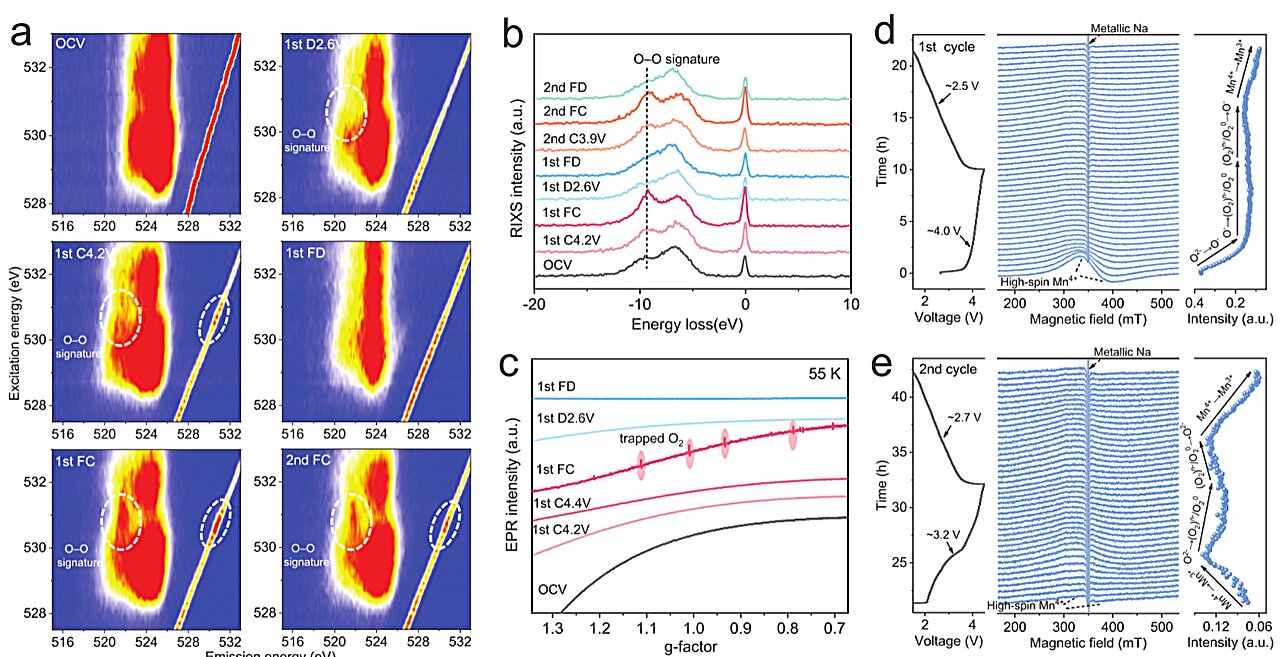Tech
Study uncovers oxygen trapping as cause of voltage loss in sodium cathodes

by Li Jingxin; Zhao Weiwei, Hefei Institutes of Physical Science, Chinese Academy of Sciences
A research team led by Prof. Li Chao from East China Normal University has uncovered the origin of voltage decay in P2-type layered oxide cathodes. Using electron paramagnetic resonance (EPR) spectroscopy at the Steady-State Strong Magnetic Field Facility (SHMFF), the Hefei Institutes of Physical Science of the Chinese Academy of Science, the team tracked the dynamic evolution of oxygen species and clarified their direct role in structural degradation.
The findings, published in Advanced Energy Materials, provide new guidance for designing more stable sodium-ion cathodes.
P2-type sodium layered oxides (NaxAyTM1-yO2) are long considered stable for anion redox reactions compared to Li-rich O3-type counterparts, with suppressed voltage decay. However, the team observed significant voltage decay in the high Na-content P2-type Na0.8Li0.26Mn0.74O2 during cycling—an anomaly unexplainable by existing theories.
The researchers identified a clear sequence of oxygen transformations upon charging, eventually leading to the formation of molecular O2. While early cycles showed that this oxygen could still be reduced during discharge, with continued cycling a growing fraction of O2 remained trapped in the discharged state. This irreversible accumulation was pinpointed as the primary driver of voltage decay and capacity loss.
In this study, EPR proved critical as it enabled noninvasive monitoring of oxygen redox behavior and revealed how reactive oxygen intermediates gradually evolve and accumulate during cycling.
EPR further exposed local structural changes: signals associated with spin interactions between manganese and oxidized oxygen became more pronounced with cycling, consistent with the development of Mn-rich and Li-rich domains. These segregation effects, exacerbated by unreduced O2, aggravated the performance degradation.

Importantly, the team also explained why high sodium-content cathodes behave differently from their low sodium-content counterparts. In high-Na materials, insufficient interlayer spacing allows migration and vacancy growth, making them vulnerable to oxygen trapping.
By contrast, low-Na cathodes with larger spacing remain stable and show no evidence of trapped oxygen.
This study highlights the unique value of EPR in battery research and suggests that bulk modification strategies are key to mitigating voltage decay and developing high-performance cathodes for next-generation batteries, according to the team.
More information:
Chunjing Hu et al, Accumulation of Unreduced Molecular O2Explains Abnormal Voltage Decay in P2‐Type Layered Oxide Cathode, Advanced Energy Materials (2025). DOI: 10.1002/aenm.202503491
Provided by
Hefei Institutes of Physical Science, Chinese Academy of Sciences
Citation:
Study uncovers oxygen trapping as cause of voltage loss in sodium cathodes (2025, November 6)
retrieved 6 November 2025
from https://techxplore.com/news/2025-11-uncovers-oxygen-voltage-loss-sodium.html
This document is subject to copyright. Apart from any fair dealing for the purpose of private study or research, no
part may be reproduced without the written permission. The content is provided for information purposes only.
Tech
The Doomsday Glacier Is Getting Closer and Closer to Irreversible Collapse

Known as the “Doomsday Glacier,” the Thwaites Glacier in Antarctica is one of the most rapidly changing glaciers on Earth, and its future evolution is one of the biggest unknowns when it comes to predicting global sea level rise.
The eastern ice shelf of the Thwaites Glacier is supported at its northern end by a ridge of the ocean floor. However, over the past two decades, cracks in the upper reaches of the glacier have increased rapidly, weakening its structural stability. A new study by the International Thwaites Glacier Collaboration (ITGC) presents a detailed record of this gradual collapse process.
Researchers at the Centre for Earth Observation and Science at the University of Manitoba, Canada, analyzed observational data from 2002 to 2022 to track the formation and propagation of cracks in the ice shelf shear zone. They discovered that as the cracks grew, the connection between the ice shelf and the mid-ocean ridge weakened, accelerating the upstream flow of ice.
The Crack in the Ice Shelf Widens in Two Stages
The study reveals that the weakening of the ice shelf occurred in four distinct phases, with crack growth occurring in two stages. In the first phase, long cracks appeared along the ice flow, gradually extending eastward. Some exceeded 8 km in length and spanned the entire shelf. In the second phase, numerous short cross-flow cracks, less than 2 km long, emerged, doubling the total length of the fissures.
Analysis of satellite images showed that the total length of the cracks increased from about 165 km in 2002 to approximately 336 km in 2021. Meanwhile, the average length of each crack decreased from 3.2 km to 1.5 km, with a notable increase in small cracks. These changes reflect a significant shift in the stress state of the ice shelf, that is, in the interaction of forces within its structure.
Between 2002 and 2006, the ice shelf accelerated as it was pulled by nearby fast-moving currents, generating compressive stress on the anchorage point, which initially stabilized the shelf. After 2007, the shear zone between the shelf and the Western ice tongue collapsed. The stress concentrated around the anchorage point, leading to the formation of large cracks.
Since 2017, these cracks have completely penetrated the ice shelf, severing the connection to the anchorage. According to researchers, this has accelerated the upstream flow of ice and turned the anchorage into a destabilizing factor.
Feedback Loop Collapse
One of the most significant findings of the study is the existence of a feedback loop: Cracks accelerate the flow of ice, and in turn, this increased speed generates new cracks. This process was clearly recorded by the GPS devices that the team deployed on the ice shelf between 2020 and 2022.
During the winter of 2020, the upward propagation of structural changes in the shear zone was particularly evident. These changes advanced at a rate of approximately 55 kilometers per year within the ice shelf, demonstrating that structural collapse in the shear zone directly impacts upstream ice flow.
Tech
Grado’s Signature S750 Headphones Sound Modern but Feel Like the ’70s

The friction-pole mechanism for headband adjustment is no less agricultural, for all its familiarity where Grado headphone designs are concerned. And while the detachable cable is a fair bit more flexible than some older Grado models, that’s not the same as saying it’s meaningfully flexible. If there’s a more willfully unhelpful length of cable in all of headphone-land, I’ve yet to encounter it.
On the subject of the cable: Grado provides 180-ish centimeters of it with a 6.3-mm termination at the end. When you’re charging this sort of money for headphones, it’s not outlandish to imagine your customer might have a device that accepts a balanced connection. Frankly, why there isn’t a choice of cables in the packaging is, frankly, beyond me. It’s something that the overwhelming majority of Grado’s rivals provide as a matter of course, and though the company’s website suggests there are forthcoming cable options “including a variety of lengths, as well as balanced terminations such as 4-pin XLR and 4.4mm,” these have been “forthcoming” for quite some time now, and will have a cost attached.
Photograph: Simon Lucas
I’m in no position to doubt the effectiveness of the “B” ear cushions where sound quality is concerned. After all, the Signature S750 sound superb, and Grado suggests the cushion design is a contributing factor. What I do feel qualified to say, though, is that the raw-feeling foam of the ear cushions is not especially comfortable, and that it retains and returns the wearer’s body heat with something approaching glee. “Premium” and “luxurious” are not words that apply.
Ultimately, it depends on what your priorities are. There’s certainly no arguing with the way the Signature S750 sound. They’re uncomplicatedly impressive and periodically quite thrilling to listen to, depending on the mix. But unless you’re one of those hair-shirt hi-fi fundamentalists from back in the day, one of those listeners who somehow doesn’t believe outstanding sound quality is valid unless there’s some suffering attached, there may well be too many shortcomings to overlook when it comes to these Grados. “Hand-assembled in Brooklyn, USA” notwithstanding.
Tech
The Future of EVs Is Foggy—but California Still Wants More of Them

It’s been a weird and confusing few weeks for the auto industry—especially for those who hoped to see more batteries on the road in the coming decade.
Just this month: Ford announced a retrenchment in its EV business, canceling some battery-powered vehicle plans and delaying others; the European Commission proposed to backtrack its goal to transition fully to zero-emission cars by 2035; the US government said it would loosen rules that would have required automakers to ratchet up the fuel economy of their fleets. BloombergNEF projects 14 million fewer EVs will be sold in the US by 2030 than it did last year—a 20 percent drop.
What has not changed, it seems, is California’s interest in shifting to cleaner transportation. “The state is doubling down on our zero-emission vehicle deployment, providing market certainty, and continuing to lead on clean transportation regardless of policy reversals elsewhere or shifts by automakers,” Anthony Martinez, a spokesperson for Governor Gavin Newsom, wrote in a statement to WIRED. He said the governor’s “commitment to accelerating California’s clean transportation transition hasn’t changed.”
In 2020, Newsom became one of the first lawmakers in the world to commit to full electrification when he signed an executive order directing state agencies to create rules that would ban the sale of new gas-powered cars in the state by 2035. Those rules eventually aimed to ratchet up the share of battery-electric vehicles, with an ultimate goal of a mix of pure EVs and plug-in hybrids. (The PHEVs could only account for about 20 percent of sales.) Several other states, including Massachusetts, New York, Oregon, and Washington State, pledged to do the same.
Earlier this year, the GOP-led Congress revoked, through legislation, California’s power to set its own clean air regulations. The state responded with a lawsuit, which is still being argued. Meanwhile, Newsom signed another executive order directing state agencies to further the state’s electrification goals in other ways.
Now auto industry experts and players say the state’s determination to push through policy and market changes to meet its now half-decade-old goal may be overly ambitious.
“Getting to 100 percent might be challenging,” says Stephanie Valdez Streaty, the director of industry insights at Cox Automotive. “There are a lot of headwinds.”
A coalition of California business groups have argued that the state’s goals even for next year—a requirement that 35 percent of model year 2026 vehicles sold are zero-emission—aren’t realistic, and that California should push back its goals for zero-emission new car sales. (Enforcement of the rules is paused while the larger battle with US Congress plays out.) Zero-emission cars accounted for 21 percent of the overall annual state new car sales as of the fall, according to the California New Car Dealers Association, well below the 35 percent goal. “The timeline needed to be adjusted,” says the group’s president, Brian Maas.
-

 Business1 week ago
Business1 week agoHitting The ‘High Notes’ In Ties: Nepal Set To Lift Ban On Indian Bills Above ₹100
-

 Business1 week ago
Business1 week agoStudying Abroad Is Costly, But Not Impossible: Experts On Smarter Financial Planning
-

 Business1 week ago
Business1 week agoKSE-100 index gains 876 points amid cut in policy rate | The Express Tribune
-

 Sports7 days ago
Sports7 days agoJets defensive lineman rips NFL officials after ejection vs Jaguars
-

 Fashion4 days ago
Fashion4 days agoIndonesia’s thrift surge fuels waste and textile industry woes
-

 Business4 days ago
Business4 days agoBP names new boss as current CEO leaves after less than two years
-

 Tech1 week ago
Tech1 week agoFor the First Time, AI Analyzes Language as Well as a Human Expert
-

 Entertainment7 days ago
Entertainment7 days agoPrince Harry, Meghan Markle’s 2025 Christmas card: A shift in strategy


















